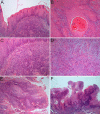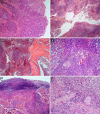Palate Squamous Cell Carcinomas:A Ten-Year Single Institute Experience
- PMID: 33717510
- PMCID: PMC7948021
- DOI: 10.12865/CHSJ.46.04.06
Palate Squamous Cell Carcinomas:A Ten-Year Single Institute Experience
Abstract
The literature date estimated that about 5% of all oral cavity cancers are hard palate cancers while soft palate cancers account for about 5-12% of oropharyngeal cancers. Although rare, usually these tumors had a more aggressively behavior than other oral cancer sites. That is why our study aimed to investigate comparatively the epidemiological, clinical and histopathological peculiarities of the two palatal sites of oral squamous cell carcinomas. We conducted a retrospective study limited to a period of 10 years in a single medical institution to investigate the morphoclinical profile of such tumors. We found that patients with hard palate SCCs had an average age slightly larger compared to those who developed soft palate tumors. Also, those with hard palate tumors are mostly diagnosed in less advanced stages compared to those at the level of the soft palate, and implicitly the former had a longer survival time. Histopathologically the most encountered hard palate SCC were the conventional well-differentiated tumor, and from the peculiar SCC variant the papillary and verrucous forms while for the soft palate SCC prevailed the moderate and poor differentiated conventional SCC and from the peculiar SCC variant the basaloid and acantholytic forms. In conclusion hard palate tumors differ in many aspects from those of the soft palate, and thus specification of the origin tumor site become important for the assessment of prognosis, treatment and survival outcome of such patients.
Keywords: Epidemiology; histopathology; oral cavity; palate; squamous cell carcinomas.
Copyright © 2014, Medical University Publishing House Craiova.
Conflict of interest statement
None to declare.
Figures



Similar articles
-
Epidemiological and Histopathological Features of Oral Squamous Cell Carcinoma-A Retrospective Study.Curr Health Sci J. 2024 Jul-Sep;50(3):411-420. doi: 10.12865/CHSJ.50.03.08. Epub 2024 Sep 30. Curr Health Sci J. 2024. PMID: 39574818 Free PMC article.
-
Epidemiological and Histopathological Aspects of Tongue Squamous Cell Carcinomas-Retrospective Study.Curr Health Sci J. 2018 Jul-Sep;44(3):211-224. doi: 10.12865/CHSJ.44.03.03. Epub 2018 Jul 15. Curr Health Sci J. 2018. PMID: 30647940 Free PMC article.
-
Clinicopathological Characteristics and Outcome Predictors in Squamous Cell Carcinoma of the Maxillary Gingiva and Hard Palate.J Oral Maxillofac Surg. 2015 Jul;73(7):1429-36. doi: 10.1016/j.joms.2014.12.034. Epub 2015 Jan 10. J Oral Maxillofac Surg. 2015. PMID: 25869748
-
Adenoid cystic carcinoma of the palate: case report and review of literature.Pan Afr Med J. 2016 May 31;24:106. doi: 10.11604/pamj.2016.24.106.8596. eCollection 2016. Pan Afr Med J. 2016. PMID: 27642445 Free PMC article. Review.
-
Multiple primary squamous cell carcinomas of the oral cavity.J Oral Maxillofac Surg. 2014 Aug;72(8):1511-6. doi: 10.1016/j.joms.2014.03.012. Epub 2014 Mar 31. J Oral Maxillofac Surg. 2014. PMID: 24813779 Review.
Cited by
-
Epidemiological and Histopathological Features of Oral Squamous Cell Carcinoma-A Retrospective Study.Curr Health Sci J. 2024 Jul-Sep;50(3):411-420. doi: 10.12865/CHSJ.50.03.08. Epub 2024 Sep 30. Curr Health Sci J. 2024. PMID: 39574818 Free PMC article.
-
Analysis of the distribution and expression of some tumor invasiveness markers in palate squamous cell carcinomas.Rom J Morphol Embryol. 2020 Oct-Dec;61(4):1259-1278. doi: 10.47162/RJME.61.4.27. Rom J Morphol Embryol. 2020. PMID: 34171074 Free PMC article.
-
Immunohistochemical evaluation of D2-40, Galectin-3, Maspin and MCM7 expression in palate squamous cell carcinomas.Rom J Morphol Embryol. 2021 Jan-Mar;62(1):133-149. doi: 10.47162/RJME.62.1.13. Rom J Morphol Embryol. 2021. PMID: 34609416 Free PMC article.
References
-
- Bray F, Ferlay J, Soerjomataram I, Siegel RL, Torre LA, Jemal A. Global cancer statistics 2018: GLOBOCAN estimates of incidence and mortality worldwide for 36 cancers in 185 countries. CA Cancer J Clin. 2018;68(6):394–424. - PubMed
-
- Abu Rass N, Surougi E, Baheydarah S, Baroom A, ALGhamdi H, AlTuwayjiri H, AlMansour N. Neoplasms of the Palate: A Review. The Egyptian Journal of Hospital Medicine. 2018;70(8):1393–1400.
-
- Chan CK, Han AY, Alonso JE, Xu MJ, Mallen-St Clair J, Heaton CM, Ryan WR, Kuan EC, St John MA. Squamous Cell Carcinoma of the Soft Palate in the United States: A Population-Based Study. Otolaryngol Head Neck Surg. 2018;159(4):662–668. - PubMed
-
- Zuydam AC, Lowe D, Brown JS, Vaughan ED, Rogers SN. Predictors of speech and swallowing function following primary surgery for oral and oropharyngeal cancer. Clin Otolaryngol. 2005;30(5):428–437. - PubMed
LinkOut - more resources
Full Text Sources
Research Materials
